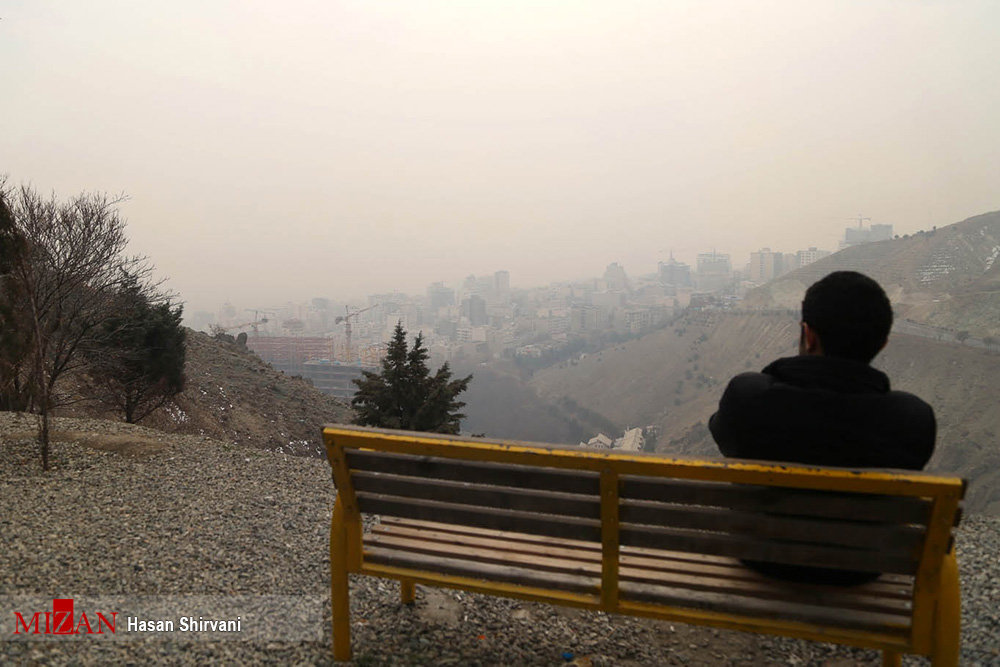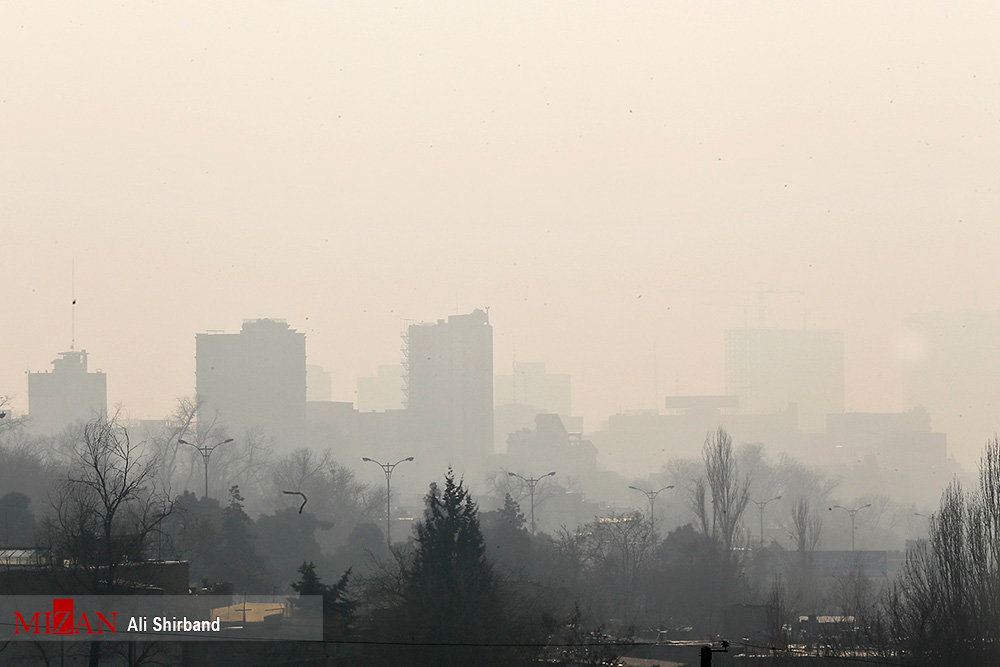Dreaming of blue skies: Tehran’s battle for clean air
A deep-seated look at the perplexing love-hate relationship Iranians share with their alarmingly polluted capital city

Tehran’s wet streets provide temporary relief to millions who have been tolerating unbearable levels of pollution. In today’s Tehran, precipitation is associated with romanticism and blessings, washing away polluted skies briefly before reality sets in again. Pollution has plagued Iran’s capital for years, manifesting in various health problems amongst locals, closing of schools, and transforming daily activities into questions of life and death.
Nested on the southern portion of the Alborz mountain range, Tehran’s prime location historically provided protection and freshwater sources to Iranians, earning the title as the nation’s capital in the late 18th century. The Alborz Mountains, which once stood as an emblem of protection for the Iranian people, have become a key obstacle in pollution alleviation. Strong winds from the western and southern belts of Tehran blow pollution from industrial factories to the center, which become captured by the mountain range in the north and east in what some refer to as a “gas chamber”.
Last month, a natural-color image produced by NASA revealed an alarming grey streak of heavy smog over Tehran. This same smog resulted in 412 Iranian lives lost in the last few weeks in the nation’s capital from pollution-related causes. Despite the alarming immediacy of these recent reports, many Iranians have become increasingly indifferent to this jaunting reality. Pollution and its ramifications are now reported as lightly as a forecast in the daily weather report, though they pose severe threats to public life, education, commerce, health and transportation.

While air pollution exists throughout the year, the situation is exacerbated in the winter months, when temperatures close to the ground are colder than those above. This restricts the natural flow of air distribution, locking harmful pollutants in a position to be inhaled by the general public.
Tehran’s pollution issue is provoked primarily by the millions of cars on the roads, poor quality of petrol, and industrial pollution from factories surrounding the city. The more than 3 million cars and motorcycles overburdening Tehran’s streets in stifling daily traffic, burn low standard fuel that contributes to more than 80% of the pollutants in the air. Further, hefty energy subsidies have promoted over consumption at a low cost amongst the public. Locals blame the government for continuing to expand car manufacturing industries instead of taking stricter measures to put the one million outdated cars off the streets.
Iranians shamelessly admit to their love-hate relationship with Tehran despite its problems. Locals are well aware of the threats Tehran’s toxic air has on their lives, dread the traffic and over crowdedness, but still choose to stay for the job opportunities and better living conditions. Migration to cities, namely Tehran, has been on the rise for this reason. Living elsewhere provides prospects of a less polluted environment and cheaper real estate, but at the cost of accessibility to many essential services only in Tehran.
Decades of crippling sanctions are partly to blame for the poor quality of petroleum, as trade embargos on Iran’s oil industry limited the import of European refined oil and led the nation to transform local petrochemical factories into oil refineries. Lead, sulfur dioxide, and benzene, all cancer-causing agents, are found at two to three times the safe levels in Tehran’s air leading to 80,000 premature deaths in 2012 alone.
Though government efforts have begun to phase out old vehicles and replaced low-quality gasoline with triple high-standard (Euro-4 grade) fuel imports, progress has been slower than expected. Dust storms originating in neighboring Iraq across the southwestern border of Iran only make matters worse. Tehran’s geographic location subjects the city to a realm of environmental issues that cannot be easily revised.
Government officials have in previous years discussed relocating the capital, but this has ignited fury over the hefty costs and impracticality that such a feat would entail. Due to declined oil revenues, the nation has less financial resources to allocate towards long-term goals. A 15-member committee to discuss whether Tehran should remain as the nation’s capital is due to reach a consensus by next year, but leaders are largely divided on what to do.
Tehran is the heart of the nation, home to government offices, leading hospitals, universities, and the majority of business affairs. If a disaster were to strike Tehran, this would paralyze the entire nation and wreak havoc in all sectors of society. Thus, decentralizing the capital city can strengthen national security, but this is economically and politically prohibitive.

Tehran’s pollution issue sheds light on the endemic issue of decision-making myopia that has plagued Iranian affairs. Exhibited both in the management and habits of the general population, short-term thinking comes with a great cost, contributing to a loss of $30 billion dollars this year.
This large-scale institutional confusion manifests on a smaller scale within the lives of individuals. Iranians shamelessly admit to their love-hate relationship with Tehran despite its problems. Locals are well aware of the threats Tehran’s toxic air has on their lives, dread the traffic and over crowdedness, but still choose to stay for the job opportunities and better living conditions. Migration to cities, namely Tehran, has been on the rise for this reason. Living elsewhere provides prospects of a less polluted environment and cheaper real estate, but at the cost of accessibility to many essential services only in Tehran.
While some locals have become desensitized to this very real issue, others are sincerely concerned and have turned to social media to express their frustration. Iran’s national Etemaad paper published a piece on its first page entitled “We are all to blame”, reminding the Iranian public that they are also accountable as the government can only do so much. Grassroots efforts to tackle pollution like “car-free Tuesday”, which is supported by the Department of Environment, are taking root in Iran’s major cities including Tehran. Local cartoonists often depict the eerie Tehran sky in their pieces, musicians ranging in age relay their grief through song, and art exhibitions by locals including children reflect the extent to which pollution has negatively impacted their lives.
Authoritative figures are reiterating the personal responsibility in resolving pollution. This includes Supreme Leader Ayatollah Khamenei, who has said it is religiously forbidden to drive vehicles in such excruciating pollution without valid rationale. Legislation is also following suit. In October, the Iranian parliament passed a new Clean Air Bill including an annual 5 percent increase in allocations for transportation services in the metropolises, motor vehicle inspections every two years instead of five, and economic benefits for companies that decide to go green. Previous attempts to implement clean air acts have been meager due to lack of enforcement.
Tehran’s pollution issue sheds light on the endemic issue of decision-making myopia that has plagued Iranian affairs. Exhibited both in the management and habits of the general population, short-term thinking comes with a great cost, contributing to a loss of $30 billion dollars this year. Tehran’s sustained presence as the nation’s capital is grounded on a principle of “survival of the first”. Business as usual continues, because as a nation with a weakened economy, short-term gains are hastily prioritized over long-term sustainable goals.
Shirin Hakim (https://www.imperial.ac.uk/people/s.hakim16) is a doctoral researcher at the Centre for Environmental Policy of Imperial College London, working on environmental issues in Iran.
Kaveh Madani (http://www.imperial.ac.uk/people/k.madani) is a reader in systems analysis and policy at the Centre for Environmental Policy of Imperial College London.
